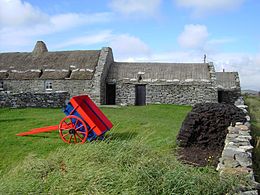Dunrossness


Dunrossness, (
Dunrossness is associated with a number of eminent people, such as Haldane Burgess, George Stewart,[4] Sir Herbert J.C. Grierson,[5] Jenny Gilbertson, Elizabeth Balneaves as well as that symbol of providence Betty Mouat. The author Sir Walter Scott visited Dunrossness in 1814 and wrote the novel The Pirate, which is set mostly in the Parish.[6] Robert Stevenson built Shetland's first lighthouse at Sumburgh Head in 1821,[6] and his son Thomas Stevenson and his grandson, the author Robert Louis Stevenson, visited the Shetland lighthouses and Fair Isle in 1870.[7]
Dunrossness had 1,505 sites of archaeological interest in 2016, 181 of them scheduled (i.e. nationally important).
Quendale beach was the site of the largest whale-kill ever recorded in Shetland in 1845 when 1,540 Long-finned Pilot Whales were driven ashore.[12]
In 1993 the oil tanker MV Braer ran aground on Garths Ness in Dunrossness releasing 85,000 tons of crude oil one of the worst oil spills in Shetland's history.[13]

References
- ^ a b Irvine (2001, p. 1)
- ^ "Shetland Islands Council Committee Information - Community Councils". Shetland Island Council. Retrieved 24 May 2016.
- ^ a b "Dunrossness Community Council Area Statement" (PDF). Shetland local plan. Shetland Islands Council. Retrieved 22 May 2016.
- ^ Irvine (2001, p. 196)
- ^ Irvine (2001, p. 198)
- ^ a b Irvine (2001, p. 82)
- ^ Irvine (2001, p. 209)
- ^ Irvine (1983, p. 27)
- ^ Campsie, Alison (9 October 2020). "The lost island settlement abandoned after it was buried in sand". The Scotsman. Retrieved 11 October 2020.
- ^ Bigelow, Gerald (2011). "Shetland Islands; Dunrossness; Broo; Survey, Paleoenvironmental Research and Excavation 2011". Journal of Archaeology Scotland. 12: 170–171 – via Academia.
- ^ "Shetland Islands Climate and Settlement Project". Bates College, Lewiston, Maine, USA. 2020. Retrieved 11 October 2020.
- ^ Evans, Peter; Harvey, Paul (2019). "Cetaceans". Nature in Shetland. Retrieved 11 October 2020.
- ^ Gervais, Marie-Claude (September 1997). "Social Representations of Nature: The Case of the Braer Oil Spill in Shetland (Doctor of Philosophy thesis)" (PDF). Department of Social Psychology, London School of Economics and Political Science, University of London.
- Irvine, James W. (2001). The Dunrossness Story. Lerwick, Shetland, U.K.: A. Irvine Printing. ISBN 0 9522638 9 0.
- Irvine, James W. (1983). Guide to Dunrossness & Fair Isle. Lerwick, Shetland, U.K.: Dunrossness Community Council.
Sources
- This article is based on http://shetlopedia.com/Dunrossness a GFDL wiki.
59°56′17″N 1°18′14″W / 59.93806°N 1.30389°W
